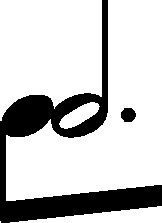



Issues : Inaccuracies in FE
|
b. 3
|
composition: Op. 11, Concerto in E minor, Mvt II
..
In FE, the f category imprint: Differences between sources issues: Inaccuracies in GE , Inaccuracies in FE , Errors in GE |
|||||||||
|
b. 13
|
composition: Op. 11, Concerto in E minor, Mvt II
..
According to us, Chopin wanted the e1 note in the 1st quaver in the top voice to be printed in a smaller font as belonging to the orchestral part only (to avoid ambiguities in the main text, we move it to the upper stave).
category imprint: Interpretations within context; Editorial revisions issues: Inaccuracies in FE |
|||||||||
|
b. 53
|
composition: Op. 11, Concerto in E minor, Mvt II
..
The literally reproduced notation of FE must be considered inaccurate if the rhythmic values in the 2nd half of the bar are correct (we omit the issue of the f category imprint: Differences between sources issues: EE revisions , Inaccuracies in FE , GE revisions |
|||||||||
|
b. 72
|
composition: Op. 11, Concerto in E minor, Mvt II
..
The absence of the category imprint: Interpretations within context issues: Inaccuracies in FE , Omission of current key accidentals , Errors repeated in GE , Errors repeated in EE |
|||||||||
|
b. 72-73
|
composition: Op. 11, Concerto in E minor, Mvt II
..
The absence of the dots increasing the duration of the bass notes most probably results from an inaccurately implemented proofreading of FE, for in this edition, there are visible traces of correcting in print the first notes in the bar from the following notation: category imprint: Interpretations within context; Source & stylistic information issues: Inaccuracies in FE , Errors resulting from corrections , Authentic corrections of FE |


 1 tied in
1 tied in 






 . It leads to the last of the suggested versions in which the correct elements of the notation of
. It leads to the last of the suggested versions in which the correct elements of the notation of 
 in sources
in sources
 minor, op. 35, the 2nd mov.,
minor, op. 35, the 2nd mov., 

 (with dots increasing the duration of notes). The unintentional character of the omission of the dots is proved by bar 75 in which a strictly analogous figure was printed already in the final layout and with a dotted minim.
(with dots increasing the duration of notes). The unintentional character of the omission of the dots is proved by bar 75 in which a strictly analogous figure was printed already in the final layout and with a dotted minim.